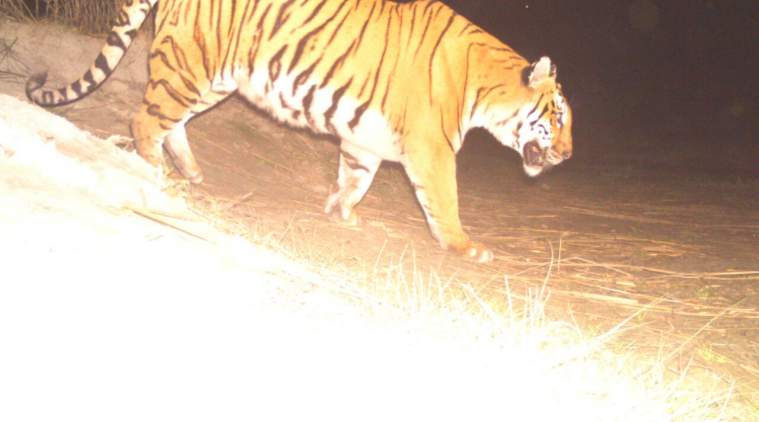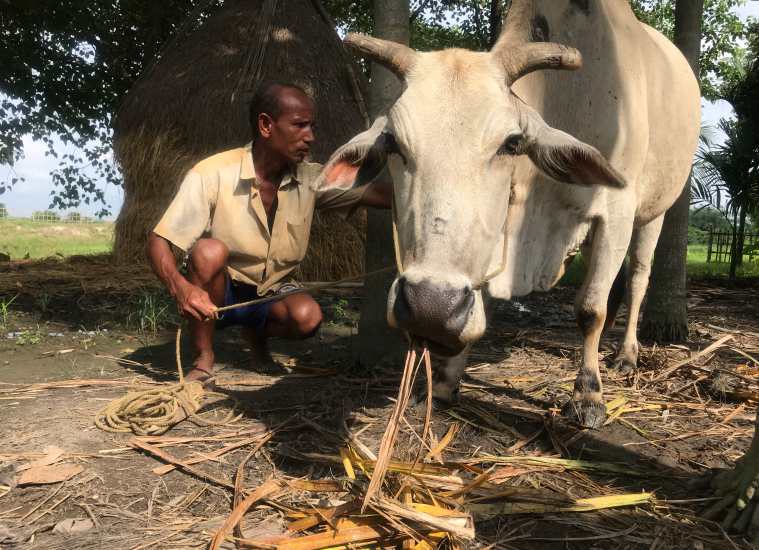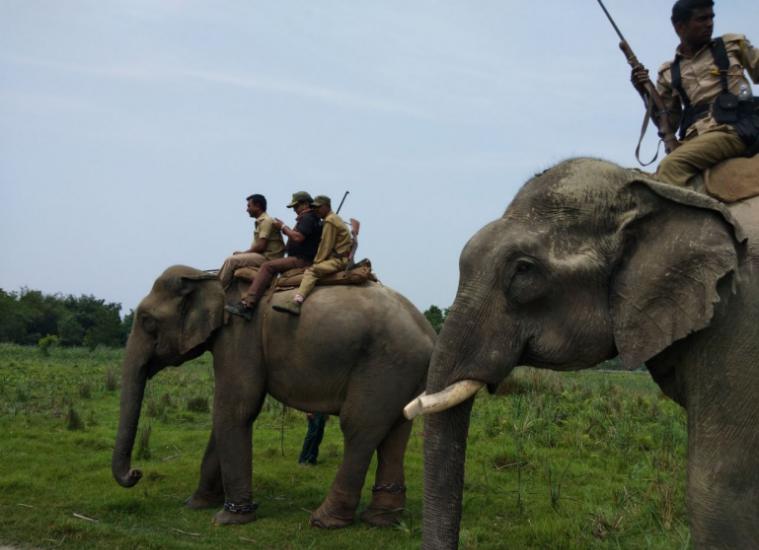Hear her roar: The tigress that stalks an Assamese village
From November 2017 to August 2018, the tigress has killed 39 animals. But for reasons best known to the villagers of Borobazar, she still roams, unscathed and free.

A camera trap capture of the Royal Bengal Tigress in Borobazar from February 2018. (Source: Assam Forest Department)
When the tigress made her first kill — a cow, bound near the yard of one Fordan Daimari — the villagers of Borobazar in Kalaigaon in Assam’s Udalguri district were not particularly alarmed. A wandering tiger in this particular vicinity, located as it is so close to the Orang National Park, is a guest who usually doesn’t overstay its welcome. Or so they thought. Over the course of that November, apart from partaking of Daimari’s cow, the tiger made seven more kills: four pigs, two cows, and a goat. And then the hamlet of Borobazar began to panic.
By day, they kept a watchful eye over their cattle which nervously grazed on a stretch of forest grassland, near which the tiger was perhaps lurking. By evening, they may well have imagined a pair of red eyes and shadowy shape skulking around Borobazar twilight roads. Come night and they were too scared to sleep. “As soon as it got dark, we would be back inside our huts. No ‘up and down’ in the streets. No going out, not even to pee,” says Marning Daimari, a villager. Two weeks back, close to a year after the tigress first strayed into their village, Daimari lost his lone cow to the apex predator.
From November 2017 to August 2018, the tigress has killed 39 animals. But for reasons best known to the villagers of Borobazar, she still roams, unscathed and free. If this was a regular man-animal conflict story, the tigress would have met her fate long back. Like, the other Royal Bengal tigress who had wandered into the midst of Borobazar in January 2016. A week later, she was found poisoned and dead. “No one in the village likes to acknowledge that incident — to kill a tiger is a sin, and they very well know that,” says Dipen Boro, the vice-president of the Assam Bodo Students Union (ABSU). The organisation, active in the Bodo Territorial Autonomous Districts, has been holding awareness camps and meetings to sensitise villagers about social issues, including wildlife conservation for years now. “To kill a tiger is not a difficult job. And yet, Borobazar has showed amazing tenacity in the past year — they have dealt with crops being ruined, animals being stolen and killed, and practically tip-toed around in their own home,” says Boro.
“Our National Property”
Contrary to popular belief, tigers living alongside men isn’t an unusual phenomenon in India. According Janaki Lenin, Tamil Nadu -based wildlife writer, “There are large wild animals living across India outside of protected areas. We just don’t know about it. In Gujarat, there are people living with crocodiles in their backyard; in Karnataka, with king cobras in their gardens. And even tigers, in Bhopal, Indore and Dudhwa,” she says, adding: “It is hard to say why people are tolerant. Very often, it is religion. Very often, it is tradition too. But sometimes it is a change in attitude.”
The 26 hamlets in and around Borobazar, mostly occupied by the Bodo tribe, practise Christianity. “We do not have any religious beliefs about the tiger but we do believe that the tiger, just like humans, has every right to live,” says Daimari, who is still waiting for compensation for his lost cow. Many echo his thoughts, and refer to the tiger as “our national property.” “Basically that means it belongs to the government, and we must take care of it,” adds Sonaram Kachari, another villager. In February 2018, then forest minister Pramila Rani Brahma had visited Borobazar about the issue. “She told us why we should cooperate, and that they are doing their best to relocate the tiger but no action has been taken yet,” says Kachari.
Ten months into her stay, the initial panic the musa (as the villagers refer to the tiger in Bodo) had created has died down, but patience is wearing thin. “How long do we wait for the Forest department to get their act together?” asks Daimari, “When we work in the fields, we keep looking over our shoulders for the fear of being attacked. Our cows are scared too.” Right at the edge of the forest which the tigress has made her home, the human residents of another home belonging to daily wage labourer couple Swaran and Rahel Baglari track their new neighbour’s movements every night. “I hear her drinking water in the pond nearby sometimes. In the morning, I see the pug marks. They are huge!” says Swaran. In February, his pigs were eaten. In July, his cow was attacked. The Baglaris who earn about Rs 250 a day say that their income is getting affected because of their new neighbour. “I lose out on several odd jobs because I am always doing ‘tiger duty’,” he says, “I mean, I have to keep watching over my cows. Earlier, I’d leave them to graze and go about my own work.”
By the side of his house, Baglari’s cow rests now, long scratches on her back and forehead. “She’s thinner and gives less milk now. I had to spend quite a bit to get her treated too,” he says, adding, “I was compensated by the Forest Department for the pigs I lost — but the money (amounting to the market price of the pig) took three months to come.”
A Wild Tiger Chase
Adult tigresses like “F-03”, the code name the Forest Department uses to refer to the Borobazar’s elusive guest, can easily take on big buffaloes. The officials first saw her in a camera trap image from December 2017, a month after she had first arrived. “We figured it was a fully-grown Royal Bengal tigress who had escaped from Orang. I do not remember exact physical specifications right now, but let’s just say if she whacked us with her paw, our heads would probably fall off!” says MK Sarma, DFO of Udalguri, under which Borobazar falls. “However, the fact that a cow was able to fend her off means that she is not very young.” In January 2018, Sarma had deputed a team of veterinary doctors to track and tranquillise the tigress so that she can be “returned”.
But for the men who have now been on lookout duty for ten months and counting, “F-03” is becoming extremely hard to nab. “A tiger is a territorial animal,” says Dr Samsul Ali, one of the two Wildlife Veterinarians who have been deputed by the Forest Department to do the job. “This one probably was ousted from Orang because she felt another tiger encroaching on her territory. Or maybe because she was old and on the lookout for easier prey.”
According to the camera trap census from 2017, there are 24 tigers in the 78.8 square km Orang National Park — undoubtably, a high density area, leading tigers to stray outside of the Park often. Added to that is the fact that Borobazar has all the qualities of an ideal refuge. “The 8km stretch of forest is thick enough for her to hide, there are enough goats and pigs for her to eat, and the Dhansiri river is her source of water,” says Dr Ali. In the beginning of August, the specialists spent a night in a makeshift hut, dressed in the guise of farmers — “We had set up traps and bait (a dead goat, pig) to lure her. And she almost came but suddenly she changed her mind and ran away to the other side of the bank,” says Dr Ali. That night, as the specialists kept a vigil, the “clever” tigress snatched a pig from the Garo hamlet on the other side of the river, much to the ire of the villagers.
“How will they catch the tiger if they spend only one night here?” says Kachari. From November till present, the team has made four visits — each lasting less than two days. “They run off to Manas or Kaziranga — the more “important” locations,” he says, adding that “Last time they came, we told them to head towards a particular location, but they went another way. Obviously they missed the tiger.”
Man vs Beast
The officials of the Forest Department feel that their hands are tied. “We need more veterinary specialists at the district level. Not just in Manas, Guwahati and Kaziranga. Often, it’s because the “doctors” — who are the only ones who can “rescue” the tiger — arrive very late. Or leave too soon,” says a department official.
Unlike elephants, tigers can’t be chased away with a sound of a gun. “While killing a tiger is easy, capturing one isn’t. The ones in Assam are particularly elusive. Unlike, say, the tigers in Uttar Pradesh, who are used to confronting humans. Ours like to hide,” says Dr Ali, “In January, I surveyed the terrain for 8 hours on an elephant. Our approach has been systematic and step-by-step,” he says, “We surveyed the land, we built machans and now we are trying to lure the tigress with a bait.”
According to Lenin, humans are not natural preys for tigers. “Take this one for example, she has lived in this village for 10 months and not even scratched a human being, despite having enormous ability to,” says Lenin, adding that the solution is not to chase the tiger away (“If there have been tigers in the past, there will be tigers in the future, too!”) but lies in an effort to help people safeguard their cattle at night by building proper enclosures. “People don’t have to suffer, the tiger doesn’t have to suffer. It’s the best of both worlds.”
Meanwhile, on the roads of Borobazar, a group of village women chat in the afternoon sun. The musa regularly comes up in conversation, often in jest. “What a bother. Sometimes at night we have to relieve ourselves in buckets inside our homes,” says Dhaneshwar Baglari, giggling. Another one jokes that perhaps the tiger doesn’t have its name in the NRC. “Maybe the tiger is Bangladeshi that’s why the government is not paying attention.” Everyone cackles. After which she says, “But we are fed up now. Does a human have to die for the government to do something?”
The veterinary specialists say they will head to Udalguri the moment news of the next (cattle) killing reaches them. “This time we will spend 15 days minimum,” says Dr Ali. However, messages from the villagers to this correspondent indicate that there have been three killings in the last week, but no sign of the team.






















 Swaran Baglari’s cow was attacked by the tigress a few weeks ago. (Express photo by Tora Agarwala)
Swaran Baglari’s cow was attacked by the tigress a few weeks ago. (Express photo by Tora Agarwala) Rahel Baglari’s home is right at the edge of the forest where the tiger hides. (Express photo by Tora Agarwala)
Rahel Baglari’s home is right at the edge of the forest where the tiger hides. (Express photo by Tora Agarwala) A forest guard climbing the machaan set up to keep a vigil on the tigress. (Source: Assam Forest Department)
A forest guard climbing the machaan set up to keep a vigil on the tigress. (Source: Assam Forest Department) In search for the tigress, the forest department officials survey the topography on elephant back. (Source: Assam Forest Department)
In search for the tigress, the forest department officials survey the topography on elephant back. (Source: Assam Forest Department) The Orang National Park which is right next to Borobazar is where the tigress escaped from.
The Orang National Park which is right next to Borobazar is where the tigress escaped from.
No hay comentarios:
Publicar un comentario